 PRESENTING:
PRESENTING:
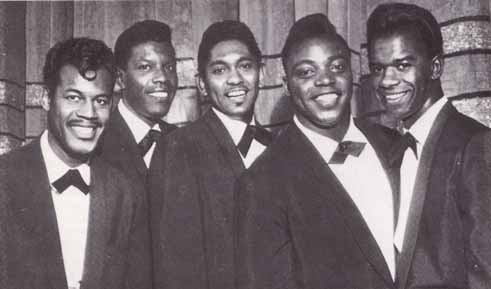
THE COASTERS
"Those Hoodlum Friends"
A Biography - by Claus Röhnisch
"If rock
´n´ roll had produced nothing but the Coasters and Leiber and Stoller, it would still
have commanded attention as the sound embodiment of a time and generation", Arnold
Shaw wrote in his book "The Rockin´ ´50s". The Coasters are widely regarded as
the pre-eminent vocal group of the original rock ´n´ roll era. "There never was -
nor will there ever be - another group quite like the Coasters. Although they worked
within the standard conventions of vocal group harmony, their signal achievement was to
create - or to have created for them - a variety of comedic roles that both celebrated and
satirized the mores of contemporary American life without falling victim to racial
stereotyping. It´s impossible to gauge which was the luckier party, whether the Coasters
were most fortunate to have Leiber and Stoller as their providers or the songwriters to
have such capable vocalists to draw out the nuances and downright insinuations in their
songs", Neil Slaven stated in a review in "Blues & Rhythm" magazine in
late 1997.
The Coasters truly deserve their high rankings in music history - hand-chosen professional
performers, all debuting during the early years of rhythm & blues and contributing to
the emerging of original rock ´n´ roll - exciting individuals, creating the best of
vocal group harmonies ever waxed.
This exciting new vocal group was born on September 28, 1955 through a recording / producing contract signed by Atlantic
Records. The new foursome had its origins
in the Los Angeles, California based vocal sextet the Robins, originally promoted by
Johnny Otis and recording since 1949 with Bobby Nunn - born September 20, 1925 in
Birmingham, Alabama - as bass/lead singer. It was the young producing /composing team of
Jerry Leiber & Mike Stoller, who with manager /salesman Lester Sill persuaded
Bobby Nunn and Carl Gardner, lead tenor vocalist with the Robins from 1954 on
Leiber-Stoller´s tiny Spark label in L.A., to leave that group and launch the new group -
called The Coasters. Gardner - born April 29, 1928 in Tyler, Texas - is still the
Coasters´ spokesman and coach today (and sang lead with the group for 50
years. The Robins´ West Coast hits from
Spark were later issued on Coasters compilations (a.o. RIOT IN CELL BLOCK #9,
FRAMED, LOOP DE LOOP MAMBO, and SMOKEY JOE´S
CAFE).
Attracted by the success of SMOKEY JOE´S CAFE with Gardner on lead
vocal, Atlantic Records signed an independent producer/composer contract with Leiber &
Stoller on that historic day of September 28, 1955. Two hand-chosen Californians, Billy
Guy (a young, slick baritone, born June 20, 1936 in Itasca, Texas)
from the duo Bip & Bop,
and Leon Hughes (born
August 26, 1932 in Los Angeles County, who had sung with the Hollywood Flames and
the Lamplighters), completed the original Coasters line-up. They were contracted to
Atlantic´s new subsidiary Atco Records (ratified in 1959 for a further seven years).
Through the Coasters Leiber-Stoller launched some of the most entertaining songs of the
´50s. The first Coasters recording was DOWN IN MEXICO from January 11,
1956 (Carl did great versions of that song in later years). The record became a
"sleeper" R&B hit - followed by the minor Pop hit ONE KISS LED TO
ANOTHER.
The group now hit the road for national promotion and produced R&B´s most famous double-sided smash in 1957 (with Gardner and Guy lead singers on one side each). YOUNG BLOOD (the original A-side) hit the national R&B Best Seller Chart #1 on June 3 and the week after its flip, SEARCHIN´, occupied that same spot for a further 12 weeks and also went to #1 on the R&B Disc Jockey and Juke Box Charts (with YOUNG BLOOD at #2). Both titles also became national Pop Top Ten hits, staying on the charts for half a year. This success stands as a rather unique achievement in American music history. Young Jessie had substituted for Hughes on that record. After three less successful, but exciting issues, (IDOL WITH THE GOLDEN HEAD, SWEET GEORGIA BROWN, and DANCE!) the Coasters reformed and - with Jerry & Mike - moved from the West Coast to New York. Bobby Nunn and Leon Hughes stayed in California, where Nunn later launched his own "The Coasters, Mark II". Nunn died of heart failure on November 5, 1986 in Los Angeles. His group, now led by Billy Richards Jr, continued to tour as "Billy Richards' Coasters". Hughes also started his own off-shoot Coasters group, "The World Famous Coasters" aka "The Original Coasters".
Two new group members were recruited by the Coasters´ prolific manager Lester Sill and shared leads on the first N.Y. Coasters Atco effort, ZING! WENT THE STRINGS OF MY HEART (a beach music classic today), recorded on March 17, 1958 in Atlantic´s new studios. Both new-comers were former L.A. experienced group singers - Will "Dub" Jones, successful bass lead with the Cadets, born in Shreveport, Louisiana on May 14, 1928 (not 1930 or 1936) - and Cornell Gunter, lead with the Flairs, born November 14, 1936 (not 1938) in Coffeyville, Kansas. The two joined Gardner and Guy to establish the classic New York quartet that recorded all the other famous Coasters' golden million sellers. YAKETY YAK (Zing's A-side, with the significant unison singing) went #1 Pop and R&B in 1958 (and received a Grammy Hall of Fame Award in 1999), although its follow-up THE SHADOW KNOWS failed. CHARLIE BROWN (#2 Pop and R&B in 1959 with its great flip THREE COOL CATS) became an international hit and was followed by ALONG CAME JONES (a #9 Pop hit b/w THAT IS ROCK & ROLL). The double-sider POISON IVY (#1 R&B and #7 Pop) b/w I´M A HOG FOR YOU became the fourth million-seller. The classic Coasters had a fifth member in guitarist Adolph Jacobs born April 15, 1939 in Sabine, East Texas, who was succeeded by a Coasters employee, Sonny Forriest, on WHAT ABOUT US b/w RUN RED RUN, which was the last single of the highly successful year of 1959.
The productions of the
Coasters´ Atco recordings were far superior to any contemporary group efforts (using the
best musicians available, especially Texan King Curtis´ fruity sax breaks) with the
lyrics neatly deriding aspects of teenage and/or black ghetto life. The group also worked
out hilarious stage routines and became the most professional act in late ´50s Rhythm
& Blues and early ´60s International Pop.
In 1960 the Coasters hit with WAKE ME, SHAKE ME and waxed
one of their all-time greatest recordings, SHOPPIN´ FOR CLOTHES (with
Guy and Jones sharing lead vocals). The flip was THE SNAKE AND THE BOOK WORM (one
of the few tracks not written by Leiber-Stoller). That year they also released their
under-rated, but qualitative "One By One" LP. In 1961 they hit
with WAIT A MINUTE (recorded in 1957). After the group´s
last U.S. Pop Top 30 hit entry, LITTLE EGYPT (YING-YANG),
Cornell Gunter left the group in June, 1961. He formed his own "Fabulous
Coasters" a couple of years later. Gunter died in his car by a gun shot from an
unknown in Las Vegas on January 26, 1990. Remnants of his group tour as "The
Original Cornell Gunter
Coasters".
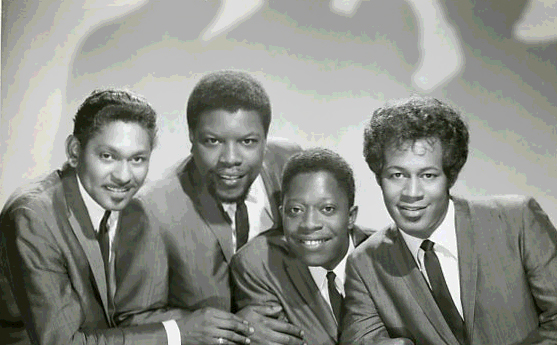
The famous former lead of the
Cadillacs, Earl "Speedo" Carroll, born November 2, 1937 in New York City, became
new second tenor in the qualitative line-up of the Coasters, which continued to record for
Atco through early 1966, with a.o. the live recording of T´AIN´T NOTHIN´
TO ME (originally issued on a various-artists "Apollo Saturday Night"
LP - hitting the Cash Box R&B Chart #20 in March, 1964); and the original recording of LET´S GO GET STONED. Three of the mid
'60s Coasters issues on Atco included a re-rendition of I MUST BE DREAMING
(originally recorded by the Robins), MONEY HONEY (a great
rendition of the original Drifters' hit) and SHE'S A YUM-YUM (the Coasters' last
Atco single, produced by King Curtis). Leiber-Stoller had left Atco/Atlantic in 1963, but
the vocal quartet renewed their collaboration with the team in late 1966, recording for
the CBS subsidiary Date Records, for which the Coasters on November 18. 1966 waxed
SOUL PAD b/w DOWN
HOME GIRL. In late October 1967 they recorded SHE CAN (later reissued
as TALKIN´ ´BOUT A WOMAN) and the wonderful original of D.W.
WASHBURN (released in 1968 and reissued on King Records in the ´70s).
In the years of the Coasters´ first revival Will Jones had left for new tasks (in New
York and later California), replaced by Ronnie Bright, born October 18, 1938 in New York
City and original bass singer in Harlem´s early ´50s group the Valentines. Billy Guy,
the great comedian of the group, had started his attempts as a solo artist back in 1962
(still recording and performing with the group up to 1973), sometimes substituted first
by Vernon Harrell and later by the hard-working soul veteran Jimmy Norman - born August
12, 1937 in Nashville, Tennessee. He had sung with Jesse Belvin´s Chargers and became a
regular Coaster in the revival line-up of the ´70s. The group performed all over U.S. and
toured Europe several times. They even made a brief come-back on the U.S. Hot 100 Chart
with a re-rendition of the Clovers'
classic LOVE POTION NUMBER NINE (for King Records in the
winter of 1971/72 with Carl Gardner as happy lead vocal) and issued a great album
produced by Leiber-Stoller on King, titled "The Coasters On Broadway". The group continued to make records - although the hits came dry. With
Gardner, Speedo, Bright and Guy they had recorded for Lloyd Price's Turntable in 1969 (ACT
RIGHT and THE WORLD IS CHANGING, produced by Jimmy Norman).
Later Ronnie Bright sang lead on CHECK MR. POPEYE, and the group, now with
Guy definately out, did a single for Wilson Pickett's Wicked label (HUSH DON'T
TALK ABOUT IT).
By
the early ´80s Carroll had left to reform his Cadillacs, and Guy and Jones
sporadically acted with a special "World Famous Coasters" in California.
Will "Dub" Jones died in Long Beach, California on January 16, 2000 at the
age of 71 after several years of semi-retirement. Billy Guy died in his
sleep at home in Las Vegas, Nevada on November 5, 2002. In 1987 the
Coasters (Gardner, Guy, Jones, and Gunter individually) were inducted into
the
Rock and Roll Hall of Fame
- the first vocal group
receiving that honor. The true
Coasters by-then touring lineup, still fronted by Carl Gardner, included
Norman, Bright, and veteran guitarist Thomas Palmer - born in El Paso, Texas
on August 15, 1929, who had joined the group already in early 1962 (debuting
on the notorious
THE CLIMB).
This became the longest lasting lineup, touring for 18 years. At times more
than ten different "Coasters" sang the hits on stage. Former Coasters Mark
II members Grady Chapman and Bobby Sheen (of the late Robins) had a Coasters
group (and even Randy Jones, who had sung with Gunter´s and Nunn´s groups,
had one). In the late ´90s "Billy Guy´s Coasters" emerged on the scene,
semi-coached by Billy Guy - that group (managed by Larry Marshak) nowadays
tours in several versions as "The Cornell Gunter Coasters". Carl Gardner and
his Coasters have - despite the competition from bogus and off-spring
Coasters groups - been heavily engaged in live bookings during the late ´80s
and the whole of the ´90s into the new millennium (even performing at the
Carnegie Hall). Carl Gardner has been up-front all the time (leading a
super-funky live version of
SMOKEY JOE'S CAFE
- the title
which was used for the famous Leiber-Stoller musical).
In
early 1998 the true Coasters were a singing quartet again (with Palmer still on
guitar). Alvin Morse (born in February, 1951) had joined the group - and in time
for Gardner´s 70th birthday Carl Gardner Jr (petnamed Mickey - born April
29, 1955) replaced Jimmy Norman, who had left to start a new reggae career.
By the end of July, 2001
Joe Lance Williams (aka J. W. Lance, who had sung with Marshak's Coasters), born
June 16, 1949, started to substitute for Gardner Jr. In November, 2004 Carl Jr
returned to his father's group and Lance stayed.
On November
5, 2005 Carl Gardner Jr officially took over lead vocals from his father, who
semi-retired (but still coaches the group).
The Coasters are probably America´s most exciting veteran vocal group of today.
We truly haven´t heard the last from them yet!
All of the Coasters´ Atco recordings are be available on a Rhino Handmade
4CD-box (with 113 tracks) issued on December 11, 2007, titled "The
Coasters On Atco - There's A Riot Goin' On".
Rhino´s "The Very Best of The Coasters" is their most
worthwhile 1CD-anthology. U.S. Rhino have also issued a terrific double CD titled "50 Coastin´ Classics"
(although out of catalogue nowadays). A 30-track
2CD-set, titled "The Definitive Soul Collection" is planned (featuring
all their pop hits).
The Coasters´ fine Date/King sides are to be found on a recommended Varese
Vintage CD, "Down Home", issued late August 2007.
- by Claus Röhnisch (revised July 26, 2008).
Bill Millar analyses
The Coasters´ innovative years

'Hello
Charlie Brown'
Although they had made nuggets before, the
Coasters did not achieve worldwide fame until "Yakety Yak" raced up the charts
on both sides of the Atlantic in 1958. The title is a throwaway comment at the end of each
verse. It follows a list of parental instructions and threats - 'If you don´t scrub that
kitchen floor, you ain´t gonna rock´n´roll no more' - which helped to define the
generation gap. "Charlie Brown", which reached Number 2 in 1959, was set in the
same context. In it the Coasters´ enumerate Charlie´s feeble attacks on authority, while
the bass voice gives expression to his wholly unbelievable innocence with the line '
Why´s everybody always pickin´ on me?'. The wheedlesome, subservient voices and
Charlie´s simple-minded non-conformism have prompted musicians and writers to complain
that Leiber and Stoller created stereotypes of black people and got too many of their
laughs by making clowns out of black vocalists. But the R&B singer, long preoccupied
with crime, sex, food and gambling, created his own stereotype of himself; Otis Redding,
for example sang of chicken-stealing. More importantly, the Coasters were clearly
irreverent and opposed institutions that white adults held in high esteem. Authority,
parents, fidelity, hard work, piety and the suppression of risky pleasures were questioned
with a bold and subversive wit. Jews (Leiber and Stoller) and Southern blacks (the
Coasters) were expected to show gratitude towards the system. Instead they stood up and
criticized it, a theme that can be recognized in almost all their songs. Southern justice,
managerial power and the gulf between black and white were satirized mercilessly. Even the
banality of television Westerns came in for gentle parody; the lyrics of "Along Came
Jones" (Number 9 in 1959) were funnier than any horse-opera dialogue you ever heard.
Eventually, few records were as contagious as "Poison Ivy (Number 7 in 1959) or the
flip "I´m A Hog For You", where the splicing together of a repeated guitar note
and grunts and squeals from the tenor sax created a vivid aural picture of pigs feeding at
a trough. It demonstrates another of the fundamental reasons for the Coasters´ appeal: if
you did miss the point you could still marvel at the sound. "Yakety Yak"
and the other discs mentioned above guaranteed the Coasters permanent place in rock´s
Hall of Fame and remain unparalleled over 20 years later (now 50; ed.not). The group
remained with Leiber and Stoller into the Sixties and the combination resulted in further
risible gems that brought vocal group production to impressive new heights.
"Shoppin´ For Clothes" (1960) resembled Chuck Berry´s love of automobile
gadgetry in its sartorial obsessiveness. The hero is looking for a suit with solid gold
buttons, a camel-hair collar and the 'cutaway, flap-over twice'. Billy Guy invested this
record, "Girls Girls Girls" and "Little Egypt" (both 1961) with the
crafty timing of a long-experienced vaudeville actor. Arguably the Coasters´ last real
classic, "Little Egypt" concerned a stripper who began her act wearing nothing
but a button and a bow. She ends up marrying the lecherous singer who concludes: 'Little
Egypt doesn´t dance there anymore, she´s too busy moppin´ and a-takin´ care of
shoppin´ at the store. ´Cos we´ve got seven kids and all day long they crawl around the
floor.' Guy snorts the lyrics with the arrogant air of one who can now enjoy Little
Egypt´s performance every night of the week. The record was subjected to a wide-spread
ban in the South, but rivaled the very best Coasters discs in every way.
A switch of
labels
Leiber and Stoller left the Coasters in 1963,
and the group played out their Atlantic contract without any chart success thereafter. In
1967 there was news of a reconciliation. The group (now with Earl Carroll from the
Cadillacs, who had succeeded Gunter a couple of years earlier; ed.note) were signed to
Date, a CBS subsidiary, and fresh Leiber and Stoller productions followed, including
"Soul Pad", "Down Home Girl" and "D.W. Washburn". "Down
Home Girl" was flecked with country-blues imagery, while "Soul Pad"
parodied health food, psychedelic rock, mysticism and other facets of counterculture. All
the songs were as sharp as anything Jerry Leiber had ever written, but the producers
failed to get the full support of CBS. The songs achieved more success in the hands of
such artists as the Monkees ("D.W. Washburn") and the Rolling Stones ("Down
Home Girl"). After a further hiatus the Coasters returned to the charts in 1971 with
another Leiber and Stoller production, "Love Potion Number 9". Since then the
group has pottered about on a variety of small labels without the benefit of Leiber and
Stoller´s wizardry.
The historical
contribution of the Coasters is real enough, however. There were cover versions and
revivals by, for example, the Hollies, Lord Sutch, the Beatles, the Fourmost, Ray Charles,
the Lambrettas, and the Tremeloes. The Coasters´ black (in both senses of the word) humor
had a formidable influence on such diverse artists as Frank Zappa, social satirist Shel
Silverstein, and Eddie Cochran - Cochran´s records often featured that moronic,
disembodied bass voice. An no less a black progressive than Curtis Mayfield stated: 'I
especially loved the Coasters.' Many groups tried to imitate the Coasters, but - unlike
the imitations - the Coasters´ records improve with age.
BILL MILLAR - 1982, 1984
(from "The History of Rock"
Volume 2 - issue 15, 1982-1984; a great magazine on the Coasters, Drifters, Platters -
Orbis Publishing Ltd, London).
In
the Beginning
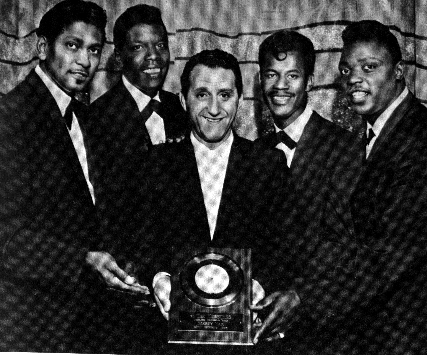
Lester Sill - Leiber/Stoller -
the Robins & the original Coasters
From "Honkers and Shouters - The Golden Years of Rhythm & Blues"
by Arnold Shaw (Collier Books, New York, 1978)
Arnold Shaw interviewing Lester Sill (The Coasters´ manager
1955 - circa 1963).
Lester Sill, today president
of Screen Gems-Columbia, the music division of Columbia Pictures Industries, started in
the record business in 1945. From that year until 1951, he worked for the Bihari brothers
of Los Angeles, first as a salesman of Modern Records, RPM, and their other labels, and
then as a producer of artists like Hadda Brooks, B. B. King, and others. We spoke in his
present office on Sunset Boulevard.
"In 1952, I went into the record distribution business myself and my shipping
clerks were Jerry Leiber and Mike Stoller. I met them in a curious way. When I was still
selling for Modern, I was on Fairfax Avenue one day and went into Norty´s Record Shop.
The moment I was inside the door, one of the stock clerks came running over to me. He had
a song he had written that he wanted me to hear. You couldn´t be in the record business
without having a song pitched at you constantly. I probably would have brushed the kid,
but he fascinated me. You see, his eyes didn´t match - one was brown and one was blue. He
grabbed me by the lapels. I couldn´t take my eyes off his eyes and the managed to shlep
me into a back room where I auditioned his song, A cappella, of course. But it had
something. And I invited him to come down that night to a Modern recording session where
the Biharis were cutting a group called the Robins. The song I had auditioned was called
"Back in the good old days" (actually "That´s what the good book
says", on March 2, 1951; ed.note). It was recorded that night. Head arrangement, of course. The stock
boy who grabbed me was Jerry Leiber. He was going to Fairfax High School at the time, or
to LA City College. That night at the session, I met his collaborator, Mike Stoller. When
I left Modern and went into the distributing business, Jerry and Mike came to work for me
as shipping clerks, Jerry more regularly than Mike. During this period, Jerry got a call
one day from Johnny Otis. He was doing a session with Willie Mae Thornton, and he needed a
song. Jerry had just finished his lunch, and the brown paper bag was still lying on the
counter. Jerry phoned Mike, and they discussed ideas for a song. Then, he wrote the lyric
on the lunch bag. I gave him some time off so that he could run over to Radio Recorders
and see Otis. The song was "Hound Dog". They were about seventeen then, and they
had already had "Kansas City", which they wrote when they were fifteen or
sixteen.
At that time, we were living on Sycamore Street, near Melrose in Los Angeles, Jerry
would come over to the house quite often. He loved my wife´s cooking, and one day he
asked if he could move in with us. We had three kids at the time, but somehow we made room
for Jerry..... During the time Jerry was living with us, I gave up the distributing
business. Jerry, Mike, Mike´s father Abe (prob. Alvin; ed.note), Jack Levy, and myself started a publishing
company called Quintet Music, Inc. We cut simple demos with Mike playing piano and Jerry
singing; or we would go and bring in some small groups to cut a demo. We had the same
problem then that most publishers have today; getting the A&R man to listen and record
your song. Jerry, Mike, and I then decided we would produce our own masters and attempt to
lease them to some record company. The first master we produced was "Black Denim
Trousers and Motorcycle Boots", sung by a group we found called The Cheers. On the
same date we also produced The Cheers doing "Bazoom". Both of these were giant
hits. I imagine this made us the first independent producers. If not the first, certainly
the first successful independent producers......
... About 1954 or 1955 (early 1954; ed.note), Leiber, Stoller, and I started a
label called Spark Records. We went on to have several hits. Then we went to a convention
in Chicago where I played some new releases for our distributors. Ahmet Ertegun of
Atlantic heard them. He came running down the hall, sort of out of the woodwork, and flew
Jerry Leiber and me into New York. Atlantic bought Spark Records, which included The
Coasters... (well not quite like that, but..; ed.note)... Atlantic set up a subsidiary label. This
was the beginning of Atco - The Coasters - and Bobby Darin.
.... after that, Mike and Jerry decided they wanted to move
to New York (late 1957; ed.note). They asked me to move with them. They had no family; I
did. My family and I decided to remain in Los Angeles. Jack Levy (and Mike´s father
before that; ed.note) and I sold our interest, allowing the boys to pay us out over a
period of a few years. When they moved, we had offices on Melrose and La Brea, which I
took over. Shortly after that, I met Lee Hazelwood (Hazlewood; ed.note) through a mutual
friend. Lee and I founded a publishing and production company called Gregmark Music. Our
first act was Duane Eddy. We produced fifteen straight chart records with Duane. About two
years later, Phil Spector stopped up to see me at 1610 Argyle, where we had just moved.
Yes, he left mother Bertha Spector, after whom he later named his publishing company... I
used to take him down to Phoenix with us, where we recorded Duane Eddy. He (Phil) absorbed
everything we did like a sponge. I met Phil right after he made "To Know Him Is To
Love Him" with the trio he called The Teddy Bears. I saw him at work in the studio
then, and he amazed me with what he was doing with vocal harmonies. He looked like he was
twelve years old. It was Bunny Robyn´s studio on Fairfax.... After we recorded
Duane Eddy in Phoenix, we brought the records back here and overdubbed them at Gold
Star..... Phil and I then started Philles Records (in late 1961;ed.note), a title
derived from the first syllables of our names.
After Lee and I parted company, I took a semihiatus for about a year and a half,
after which I was approached by Don Kirshner, then president of Screen Gems-Columbia
Music, Inc., and now the Rock Concert impresario, to come into the organization as a
consultant. It was to be a temporary situation because I didn´t want to get locked into a
big company at that time. The end result is that after twelve years, I am still with
Screen Gems-Columbia Music..."
(Lester Sill stayed with Screen Gems for 21 years ending up as President - and
ended his days as head of the huge "Motown" publishing firm Jobete Music, where
he landed in 1985 - and died in 1994; ed.note).
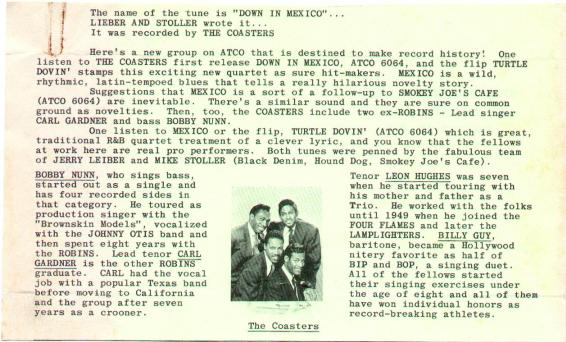
The first promotional letter for the Coasters
from Milton Deutsch Agency of Hollywood, Calif.
Gary/Oldies Magazine # 55
(June 2001)
From Jim Bishop: MIKE STOLLER & JERRY LEIBER
Tuesday, April 3, 2001, BY FRANCINE RUSSO
Hours after escaping the wreck of the Andrea Doria, 22-year-old composer Mike Stoller
peered from the deck of a rescue ship as it entered New York harbor to see his lyricist
partner Jerry Leiber, also 22, lounging on the pier, holding an Italian silk suit--in case
Mike needed dry clothes. "We have a hit!" Leiber cried. "Hound
Dog...recorded by some kid named Elvis." That was July 1956. And while
lots of folks will tell you that when they heard Elvis shout "You ain't nothin' but a
hound dog!" it changed music forever, the revolution was already well under way. In
fact, you could say it began in 1950, when a pair of 17-year-old white kids named Leiber
and Stoller teamed up to write for black rhythm-and-blues performers like Jimmy
Witherspoon and Big Mama Thornton--for whom they yelled and banged out "Hound
Dog" in 10 inspired minutes.
This month Leiber and Stoller, now Rock and Roll Hall of Famers, celebrate their
half-century mark as partners and accept the Johnny Mercer Award from the National Academy
of Popular Music/Songwriters' Hall of Fame. As songwriters, record producers,
record-company owners and music publishers, they are legends in the business, having
written and produced scores of hits--from the rhythm and blues of Kansas City to witty pop
ditties like "Yakety Yak" and "Poison Ivy" and soul classics like
"Stand by Me." Fifty years after they penned their first song, their exuberant
music is still everywhere, blasting out of the radio on old records and new CDs, jiving up
TV commercials and lending grit to movie sound tracks. Their song collection, Smokey Joe's
Cafe, became the longest-running revue in Broadway history, toured Europe and Japan, and
is now playing Las Vegas and Seoul. Their collaboration began in Los Angeles, when
Leiber, then in high school and boasting a copybook scrawled with song lyrics, called up
Stoller, a friend of a friend who he'd heard wrote music. Stoller, a Long Island, N.Y.,
native, had fallen in love with boogie-woogie piano at an interracial summer camp. Leiber
had breathed it in from the black households in Baltimore to which he had delivered
kerosene and coal from his mom's grocery store. They bonded over 12-bar blues and had
almost immediate success writing for black artists. "These were called 'race
records,'" Stoller recalls, "meaning they were played only on stations that
catered to a black audience." It was the young songwriters' destiny to become a major
conduit of black music to white audiences. When Elvis' version of "Hound
Dog" exploded on the scene, their fortunes soared. Asked by Elvis' producers
for more songs, they wrote more than 20, including "Love Me," "Treat Me
Nice," "Loving You" and "Jailhouse Rock." "We became his
lucky charm," Stoller says of Elvis, then laughs and adds, "until we got
bored." "We wrote to amuse ourselves," Leiber says. It shows in the
manic energy and irrepressible good humor of their music. It's still hard not to laugh at
the comic tunes they wrote for the Coasters, such as "Charlie Brown" and
"Love Potion No. 9." Such story songs as "Along Came Jones" and
"Young Blood" were inspired by Leiber's love of radio series like "The
Shadow." Their subjects ranged from knife fights and no-accounts to class clowns and
the clap. That last can be found in what Leiber calls the "snide innuendo" of
their hilarious "Poison Ivy."
In the late '50s, the pair began working with other writers and producing records
for such artists as the Drifters and Ben E. King. Stoller recalls the creation of
"There Goes My Baby" and the birth of soul. "I started playing a
counterline on the piano that was like a Rimsky-Korsakov melody. Jerry said, 'That sounds
like strings,' and I said, 'Why not? Let's do it.'" So came the first R&B record
with strings. With "Spanish Harlem," they added Brazilian and African
percussion. Then came the restlessness. "It was the era of the girl
groups," Stoller says. "The focus of songs was getting younger and younger. We
decided to try to write in a different vein." "Is That All There Is?",
recorded by Peggy Lee in 1969, was the kind of arty cabaret song they meant. They wrote
for the theater but weren't taken seriously. After the runaway success of Smokey Joe's,
they're reworking two book musicals they wrote at that time. Their classic songs
have been recorded by artists as varied as the Beatles, John Mellencamp, Lou Rawls, Aretha
Franklin and Barbra Streisand. "Kansas City" alone, Stoller guesses, has had
about 500 versions. Not long ago, the two were invited to the White House. President
Clinton was excited to meet them, Stoller recalls fondly: "He broke out singing, 'The
neon lights are bright on Broadway...'" Did they ever think when they began that
someday the president of the U.S. would croon one of their songs to them? Stoller laughs.
"We thought if we were really lucky they might last six months."
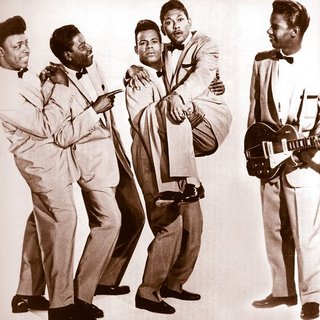
Robert
Christgau on The Coasters
Presenting The Coasters, edited by Claus Röhnisch July 3, 2007
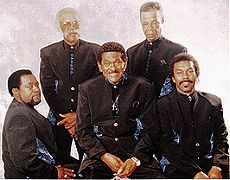

Summary
| Singles
& LPs | CD Discography | Session
Discography | Time-Line |
Line-Ups
| Chart Hits
| The Golden ´50s